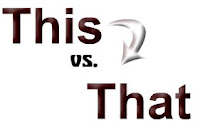
Manual vs. Automatic
 |
| 1989 International Flatbed/Dump Truck |
Ok, so I used to drive a ST (Standard Transmission - as oppose to an AT (Automatic Transmission)) car for many, many years. Hell!, at one point I even tried my hand at trucking, driving one of those old International flatbed trucks with the classic 5 speed and a 2 speed rear end transmission. What an experience!
Either way, driving a ST car was always my preference until one day I fell in love with a particular car which was not manufactured with the manual clutch. So now, I'm driving automatic. But eventually, I will probably go back to standard again.
Anyways, with all this standard driving, I really didn't think there were any major differences other than the fact that one was much more fun and interesting to drive than the other, lol. But there are actually some interesting points between the two that you should consider before driving or purchasing one that's right for you!
Costs
Manual transmissions cost less than automatics to begin with. When you go to a car dealear you will notice that the stick-shift version of the same model is about a thousand bucks cheaper. Sometimes a thousand dollars seems like not not so much when it comes to buying a new car but forget about the car itself, think of what you can do with an extra $1000.
In the long run, manuals require less service, thus making maintenance cheaper too.
Any mechanic can tell you that working on a manual transmission is much easier than working with automatic gear boxes. So the repair costs for automatics are significantly higher.
Manuals - if properly operated - will go hundreds of thousands of kilometers without problems (well, you also need a good car). The lubricant needs to be replaced periodically but not as frequently as in automatics. (Some cars use special transmission fluids that do not need to be replaced at all.)
Operation (driving)
Standards are harder to drive. Say the North Americans. Huh. Ask a European taxi driver who talks to the dispatcher and zig-zags on narrow winding streets with three passangers chatting in the background. He will swear to the life of his mother that stick shifs are better. With ATs, at stop lights you have to keep your foot on the brake pedal otherwise the start keeps rolling forward. Just how uncomfortable is that?
The main difference in operating a car with a stick shift vs. one with automatic trasmission is that you need to shift gears based on the vehicle's speed and this requires the use of the clutch pedal and the gear shift (stick). When the clutch pedal is depressed the clutch is disengaged - the engine and the transmission is separated. Gears can be selected at this time or the car can be stopped without stalling.
 |
| Standard Gear Selector |
Automatics also have a clutch except instead of a clutch pedal a torque converter is used to seperate the engine from the transmission - and it all happens automatically without the need of driver input. Speaking of driver input: manual enthusiasts need all their pride and discipline in traffic jams when they need to shift gears every minute for hours. (hint: if you commute in bad traffic, buy an automatic and forget about control- it's just not worth the stress driving a stick shift through traffic jams).
Summary
Overall, it seems the standard transmission wins hands down in terms of cost, low maintenance and efficiency.
Pros of ST cars:
- Control - You get more with ST cars.
- Vehicle cost - ST cars are usually cheaper.
- Fuel economy - Cars with manual transmission consume 5%-15% less fuel depending on road conditons and driving habits.
- Maintenance - Manual transmission don't need as much maintenance as automatics and when they do, the repair costs are much cheaper.
- Weight - Manual transmission boxes are ligher than automatics.
- Cooling - It's much easier for an automatic transmission to overheat.
- Efficiency - Standards are more efficient.
- It requires more "hands-on" experience.
- In heavy traffic jams or constantly driving in congested cities, automatic would be the better choice.
Source: manualversusautomatic.com



No comments:
Post a Comment
Hey! Thanks for leaving your comment!